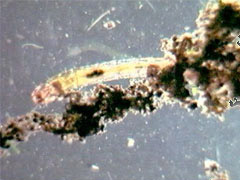Chironomid (Insects)
In addition to supporting the biomass of the freshwater fishes community, non-biting midges or chironomids are essential in the diets of many migratory shorebirds and waterfowl. Water pollution and aquatic habitat destruction, as well as land use practices and indiscriminant pesticide use, threaten these very diverse and widespread dipterans worldwide.

Chironomid Video #1 - A chironomid larva is energetically foraging through debris, assisted occasionally by a metal forceps; under oblique illumination with a playing time of 46 seconds. Choose a playback format that matches your connection speed:
Easily confused with biting blackflies (Simulidae) and mosquitoes (Culicidae) by the public, these insects do not bite or sting as larvae or adults. The larvae, instead, feed on periphyton, while the pupae and adults do not eat. Even most entomologists have trouble distinguishing species of midges as doing so requires highly specialized specimen preparation (head capsule clearing and mounting), tedious dichotomous keys followed meticulously under a microscope, and long hours of advanced training and experience. Typical of other aquatic representatives of the order Diptera, the Chironomidae family features a complete metamorphic life cycle including egg, larval (4 instars), pupal, imago, and flying adult life stages. Having a single pair of functional wings, the aerial adults often bear relatively large, feather-like antennae, which may provide protection akin to radar for detecting airborne predators such as dragonflies, birds, and bats. Most species, during the larval stage, construct ventilated tubes of algae or debris for domiciles.
Wormlike in appearance, chironomid larvae are typically found burrowing in the soft sediments of ponds, lakes, and wetlands, but also occur in stream and marine ecosystems, as well as in some semi-terrestrial and terrestrial habitats. The ice worm, in accord with its name, is a chironomid found in the frozen waters and chilling temperatures of New Zealand's west coast glaciers. At the other temperature extreme for living creatures, there are midges that survive geothermal waters and conditions of volcanism up to temperatures of 45 degrees Celsius, and as acidic as pH 1.8. Blood worms, named because of their bright red color associated with oxygen-binding erythrocruorin, can survive the low-oxygen or anoxic conditions found in stagnant pools, anaerobic wetland sediments, and sewage lagoons. In ecologically sensitive systems such as Kansas' 41,000-acre Cheyenne Bottoms wetland ecosystem, where about 45 percent of North America's shorebirds stop during spring migration for vital "fuel", midge larvae densities can be as high as 50 larvae in each square-inch of mud (or 77,520 midge larvae per square meter). Some of the chironomids reach over one inch in length, accounting for an enormous amount of the biodiversity and biomass of this area, which is designated as a member of the "Wetlands of International Importance". Many of the methods employed for controlling disease-vector insects, such as aerial spraying of mosquito insecticides, are not well targeted and non-selectively kill many types and large numbers of non-biting midges, to the detriment of dependent fishes and birds.
